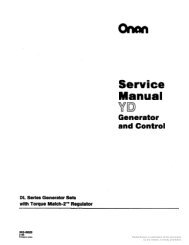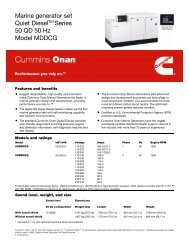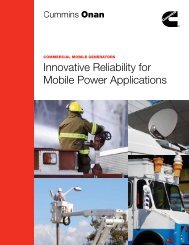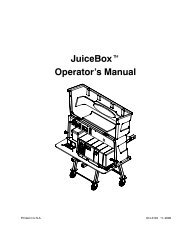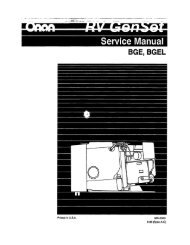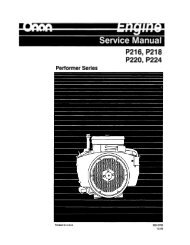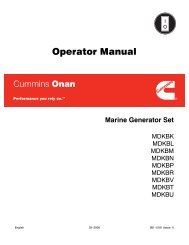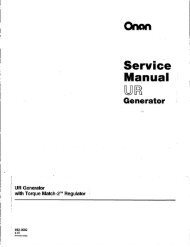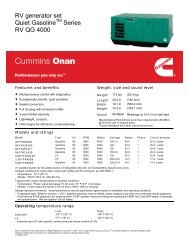Caution: This document contains mixed page sizes ... - Cummins Onan
Caution: This document contains mixed page sizes ... - Cummins Onan
Caution: This document contains mixed page sizes ... - Cummins Onan
You also want an ePaper? Increase the reach of your titles
YUMPU automatically turns print PDFs into web optimized ePapers that Google loves.
AUTOMATIC STARTING AND STOPPING<br />
The vehicle may be equipped with an inverter-charger<br />
or other automatic genset starting device<br />
(AGS). Always follow the instructions and safety<br />
precautions provided by the manufacturer of the automatic<br />
starting device when enabling automatic<br />
genset starting.<br />
WARNING EXHAUST GAS is deadly. MOV-<br />
ING PARTS and ELECTRICITY can cause severe<br />
personal injury or death. To reduce exposure to<br />
these hazards, always disable automatic genset<br />
starting before:<br />
Sleeping in vehicle, unless vehicle has a<br />
working CARBON MONOXIDE detector<br />
Parking vehicle in garage or confined space<br />
Parking vehicle for storage<br />
Servicing genset<br />
Servicing batteries<br />
Servicing electrical appliances<br />
Fueling vehicle<br />
LOADING THE GENSET<br />
The genset can power AC motors, air conditioners,<br />
AC/DC converters, battery chargers and other appliances.<br />
How much appliance load* can be powered<br />
depends upon the genset power rating. The<br />
genset will shut down or its circuit breakers will trip if<br />
the sum of the loads exceeds genset power. See<br />
Section 12. Troubleshooting.<br />
To avoid overloading the genset and causing shutdowns,<br />
compare the sum of the loads of the appliances<br />
that are likely to be used at the same time to<br />
the power rating of the genset. It may be necessary<br />
to run fewer appliances at the same time—<br />
the sum of the loads must not be greater than<br />
genset rating.<br />
The genset may shut down due to overload when a<br />
large motor or air conditioner is started or cycles off<br />
and then on again, even though the sum of the loads<br />
is less than genset rating. The reason for this is that<br />
a motor’s startup load is much larger than its running<br />
load. It may be necessary to run fewer appliances<br />
when large motors and air conditioners<br />
are cycling on and off.<br />
Maximum power decreases as altitude increases<br />
because air density decreases. For every 1000-foot<br />
(305 m) increase in elevation you can expect power<br />
to decrease approximately 3.5 percent. Table 2-1<br />
shows the results of typical calculations. It may be<br />
necessary to run fewer appliances at higher altitudes.<br />
TABLE 2-1. POWER VS. ALTITUDE<br />
Elevation above Sea<br />
Maximum Power<br />
Level<br />
at/below 500 ft (152 m)<br />
at 2500 ft (762 m)<br />
at 5500 ft (1676 m)<br />
above 5500 ft (1676 m)<br />
12,000 W (rated)<br />
11,280 W<br />
10,200 W<br />
10,200 W minus 360 W<br />
every 1000 ft (305 m)<br />
* Appliance load and genset power are measured in terms of watts (W) or kilowatts (kW), where 1 kilowatt (kW) = 1000 watts (W).<br />
2-5



